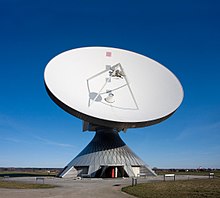Parabolic mirror





A parabolic mirror is a concave mirror in the form of a paraboloid of revolution . For optical applications it consists of glass or ceramic and is brought into the desired shape by precise mirror grinding . For radio waves, the paraboloid is usually formed from metal plates or grids.
Parabolic mirrors have the property of collecting rays arriving parallel to the axis exactly at their focal point . They are used as receivers for distant objects ( satellite communication or radar antennas , astronomical radio telescopes and optical reflector telescopes ) or vice versa for radar focusing and long-range searchlights . In contrast, the parabolic trough curved in one dimension concentrates plane waves along a straight line .
Parabolic mirrors work largely independently of the type of wave, provided that the mirror is large compared to the wavelength and the wave is reflected on the surface. The mirrors are suitable for electromagnetic waves such as light , radar or radio waves . Even the sound waves can be focused or radiate from there in plane form with parabolic mirrors in a focal point.
Focus property of parabolic surfaces
A parabola is the set of all points whose distance to a special fixed point is the same as that to a special straight line. The special point is the focal point of the parabola. The special straight line is the guide line of the parabola.
The perpendicular PG of the triangle PQF is the tangent to the parabola at point P. It forms the same angle with the ray PF and the perpendicular incident ray, so it reflects the latter in the direction of F, the focal point.
By rotating around its axis of symmetry, the parabola becomes the paraboloid of revolution, the reflecting surface of a parabolic mirror.
A small area of the parabola on both sides of the vertex A is approximately a circle. It is the area of the solid angle starting from point F , which is used by spherical concave mirrors (or spherical mirrors ). Such mirrors are easier to manufacture and therefore cheaper than parabolic mirrors. They also bundle incident parallel light approximately in one point. If they are used as reflectors for a (point) light source to generate a parallel light beam, their smaller solid angle has a disadvantageous effect because less light is captured.
Applications
Parabolic mirrors are used both to receive (e.g. satellite reception, reflecting telescopes) waves from a certain direction and to transmit (e.g. directional radio, radar) waves in a certain direction. Frequently, one and the same parabolic mirror is used to send and receive ( time division multiplexing ).
light
In headlights , the radial light rays from a point light source are reflected with parabolic mirrors in such a way that the majority of the rays emerge almost parallel.
The mirrors of reflecting telescopes are parabolic mirrors in some types. They are used to concentrate the (parallel) light from stars and other astronomical observation objects to such an extent that their intensity is sufficient to be seen with the eye or measured in detectors. The best-known example are the mirrors of Newtonian telescopes with a large mirror diameter compared to the focal length , i. H. a "fast" focal ratio. From a ratio of approx. 8: 1, a parabolic mirror and a spherical mirror (which are easier to manufacture) are so similar that parabolic mirrors are not used in some Newtonian telescopes for reasons of cost. The mirror telescopes used today in large-scale research are mostly Ritchey-Chrétien-Cassegrain telescopes , which work with a system of two hyperbolic mirror surfaces.
Another important application for harnessing solar energy is the bundling of thermal radiation with large parabolic mirrors. This enables high temperatures to be reached in the area of the most thermally effective focal point. The energy available can be used to melt metals (see solar furnace ) or to generate steam (see solar thermal power plant ). Small-scale applications such as solar cookers also often use parabolic mirrors to bundle solar energy. This principle was also used in ancient times to light the Olympic flame, with a torch being lit at the focal point.
Radar and radio waves
Long-range radars are equipped with parabolic mirrors to give the antenna pattern good directivity.
In radio astronomy , extremely large metal parabolic mirrors are used, which are similar to the mirrors in radar devices.
In directional radio links , parabolic mirrors in the form of parabolic antennas are used for both the transmitter and the receiver . In this way, a communication link can be established over long distances with comparatively little transmission power.
The receiving antennas for satellite television are also parabolic antennas.
sound
In the whisper vaults , the walls are almost parabolic in shape. In this way, even quiet noises at the focal point are transmitted over long distances without great loss.
A microphone at the focal point of a parabolic mirror receives sound from the direction of the mirror axis. Interfering noises coming from other directions are only weakly received. This construction is suitable for. B. as a directional microphone .
literature
- Sebastian von Hoerner , Karl Schaifers : Meyer's manual about the universe. Bibliographisches Institut, Mannheim 1960 (Chapter 2.1: Optical Systems ).
- Eberhard Spindler: The great antenna book. Calculation and self-construction of receiving antennas. 11th, revised edition, Franzis, Munich 1987, ISBN 3-7723-8761-6 .
- W. Jahn: The optical observation instruments. In: Handbook for Star Friends. 3rd, revised and expanded edition, Springer, Berlin et al. 1981, ISBN 3-540-10102-0 , pp. 9–79 ( online ).
- Albrecht Unsöld , Bodo Baschek : The new cosmos. Introduction to astronomy and astrophysics. Springer, Berlin et al. 2002, ISBN 978-3-540-42177-1 (Chapter 5.1: Telescopes ).


